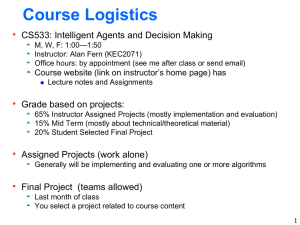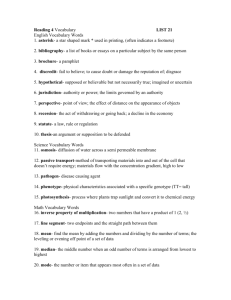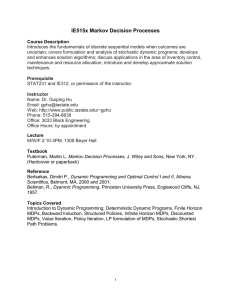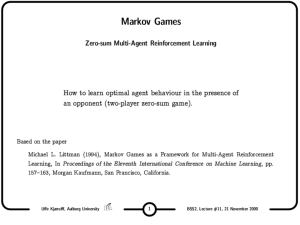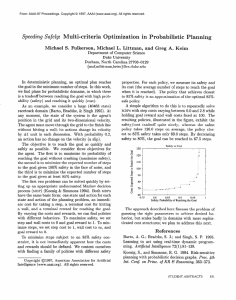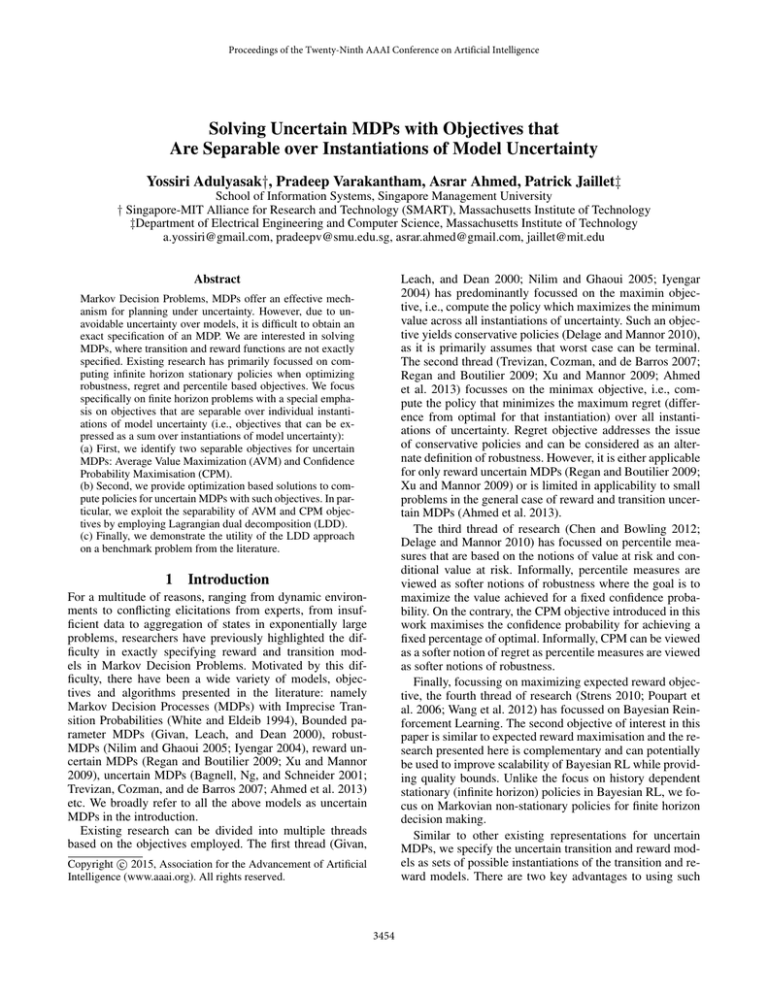
Proceedings of the Twenty-Ninth AAAI Conference on Artificial Intelligence
Solving Uncertain MDPs with Objectives that
Are Separable over Instantiations of Model Uncertainty
Yossiri Adulyasak†, Pradeep Varakantham, Asrar Ahmed, Patrick Jaillet‡
School of Information Systems, Singapore Management University
† Singapore-MIT Alliance for Research and Technology (SMART), Massachusetts Institute of Technology
‡Department of Electrical Engineering and Computer Science, Massachusetts Institute of Technology
a.yossiri@gmail.com, pradeepv@smu.edu.sg, asrar.ahmed@gmail.com, jaillet@mit.edu
Abstract
Leach, and Dean 2000; Nilim and Ghaoui 2005; Iyengar
2004) has predominantly focussed on the maximin objective, i.e., compute the policy which maximizes the minimum
value across all instantiations of uncertainty. Such an objective yields conservative policies (Delage and Mannor 2010),
as it is primarily assumes that worst case can be terminal.
The second thread (Trevizan, Cozman, and de Barros 2007;
Regan and Boutilier 2009; Xu and Mannor 2009; Ahmed
et al. 2013) focusses on the minimax objective, i.e., compute the policy that minimizes the maximum regret (difference from optimal for that instantiation) over all instantiations of uncertainty. Regret objective addresses the issue
of conservative policies and can be considered as an alternate definition of robustness. However, it is either applicable
for only reward uncertain MDPs (Regan and Boutilier 2009;
Xu and Mannor 2009) or is limited in applicability to small
problems in the general case of reward and transition uncertain MDPs (Ahmed et al. 2013).
The third thread of research (Chen and Bowling 2012;
Delage and Mannor 2010) has focussed on percentile measures that are based on the notions of value at risk and conditional value at risk. Informally, percentile measures are
viewed as softer notions of robustness where the goal is to
maximize the value achieved for a fixed confidence probability. On the contrary, the CPM objective introduced in this
work maximises the confidence probability for achieving a
fixed percentage of optimal. Informally, CPM can be viewed
as a softer notion of regret as percentile measures are viewed
as softer notions of robustness.
Finally, focussing on maximizing expected reward objective, the fourth thread of research (Strens 2010; Poupart et
al. 2006; Wang et al. 2012) has focussed on Bayesian Reinforcement Learning. The second objective of interest in this
paper is similar to expected reward maximisation and the research presented here is complementary and can potentially
be used to improve scalability of Bayesian RL while providing quality bounds. Unlike the focus on history dependent
stationary (infinite horizon) policies in Bayesian RL, we focus on Markovian non-stationary policies for finite horizon
decision making.
Similar to other existing representations for uncertain
MDPs, we specify the uncertain transition and reward models as sets of possible instantiations of the transition and reward models. There are two key advantages to using such
Markov Decision Problems, MDPs offer an effective mechanism for planning under uncertainty. However, due to unavoidable uncertainty over models, it is difficult to obtain an
exact specification of an MDP. We are interested in solving
MDPs, where transition and reward functions are not exactly
specified. Existing research has primarily focussed on computing infinite horizon stationary policies when optimizing
robustness, regret and percentile based objectives. We focus
specifically on finite horizon problems with a special emphasis on objectives that are separable over individual instantiations of model uncertainty (i.e., objectives that can be expressed as a sum over instantiations of model uncertainty):
(a) First, we identify two separable objectives for uncertain
MDPs: Average Value Maximization (AVM) and Confidence
Probability Maximisation (CPM).
(b) Second, we provide optimization based solutions to compute policies for uncertain MDPs with such objectives. In particular, we exploit the separability of AVM and CPM objectives by employing Lagrangian dual decomposition (LDD).
(c) Finally, we demonstrate the utility of the LDD approach
on a benchmark problem from the literature.
1
Introduction
For a multitude of reasons, ranging from dynamic environments to conflicting elicitations from experts, from insufficient data to aggregation of states in exponentially large
problems, researchers have previously highlighted the difficulty in exactly specifying reward and transition models in Markov Decision Problems. Motivated by this difficulty, there have been a wide variety of models, objectives and algorithms presented in the literature: namely
Markov Decision Processes (MDPs) with Imprecise Transition Probabilities (White and Eldeib 1994), Bounded parameter MDPs (Givan, Leach, and Dean 2000), robustMDPs (Nilim and Ghaoui 2005; Iyengar 2004), reward uncertain MDPs (Regan and Boutilier 2009; Xu and Mannor
2009), uncertain MDPs (Bagnell, Ng, and Schneider 2001;
Trevizan, Cozman, and de Barros 2007; Ahmed et al. 2013)
etc. We broadly refer to all the above models as uncertain
MDPs in the introduction.
Existing research can be divided into multiple threads
based on the objectives employed. The first thread (Givan,
c 2015, Association for the Advancement of Artificial
Copyright Intelligence (www.aaai.org). All rights reserved.
3454
ξ of transition and reward models:
1 X
max
vq (~π 0 )
0
Q q
~
π
a model over other representations: (a) First, since there are
no assumptions made on the uncertainty sets (e.g., imposing
continuous intervals or convex uncertainty sets) and since
we only require a simulator, such a model is general; and
(b) We can represent dependence in probability distributions
of uncertainty across time steps and states. This dependence
is important for characterizing many important applications.
For instance, in disaster rescue, if a part of the building
breaks, then the parts of the building next to it also have a
higher risk of falling. Capturing such dependencies of transitions or rewards across states has received scant attention
in the literature.
Our contribution is a general decomposition approach
based on Lagrangian dual decomposition to exploit separable structure present in certain optimization objectives for
uncertain MDPs. An advantage of our approach is the presence of posterior quality guarantees. Finally, we provide experimental results on a disaster rescue problem from the literature to demonstrate the utility of our approach with respect to both solution quality and run-time in comparison
with benchmark approaches.
2
• In CPM, we compute a policy, ~π 0 that maximizes the
probability over all samples, ξ, Pξ () that the value,
vq (~π 0 ) obtained is at least β% of the optimal value, v̂q∗
for that same sample:
β ∗
0
max
Pξ vq (~π ) ≥
v̂
(1)
100 q
~
π0
The sample set, ξ based representation for uncertain transition and reward functions is general and can be generated
from other representations of uncertainty such as bounded
intervals. It should be noted that our policy computation can
just focus on a limited number of samples and using principles of Sample Average Approximation (Ahmed et al. 2013)
we can find empirical guarantees on solution quality for a
larger set of samples. The limited number of samples can be
obtained using sample selection heuristics, such as greedy
or maximum entropy (Ahmed et al. 2013).
Model: Uncertain MDPs
We now provide the formal definition for uncertain MDP.
A sample is used to represent an MDP that is obtained by
taking an instantiation from the uncertainty distribution over
transition and reward models in an uncertain MDP. Since
we consider multiple objectives, we exclude objective in the
definition of an uncertain MDP and then describe the various objectives separately. An uncertain MDP (Ahmed et al.
2013) captures uncertainty over the transition and reward
models in an MDP. A finite horizon uncertain MDP is defined as the tuple: hS, A, ξ, Q, Hi. S denotes the set of states
and A denotes the set of actions. ξ denotes the set of transition and reward models with Q (finite) elements. A sample ξq in this set is given by ξq = hTq , Rq i, where Tq and
Rq denote transition and reward functions for that sample.
Tqt (s, a, s0 ) represents the probability of transitioning from
state s ∈ S to state s0 ∈ S on taking action a ∈ A at time
step t according to the q th sample in ξ. Similarly, Rtq (s, a)
represents the reward obtained on taking action a in state s
at time t according to qth sample in ξ. Finally, H is the time
horizon.
We do not assume the knowledge of the distribution over
the elements in sets {Tq }q≤Q or {Rq }q≤Q . Also, an uncertain MDP captures the general case where uncertainty distribution across states and across time steps are dependent
on each other. This is possible because each of our samples
is a transition and reward function, each of which is defined
over the entire time horizon.
We consider two key objectives1 :
• In AVM, we compute a policy, ~π 0 that maximizes the average of expected values, vq (~π 0 ) across all the samples,
3
Solving Uncertain MDPs with Separable
Objectives
We first provide the notation in Table 1. Our approach to
Symbol
~π 0
xtq (s, a)
πqt (s, a)
δ(s)
ξq
Description
Policy
time steps,given by
0 for all
π , . . . , π t , . . . , π H−1
Number of times action a is executed in state s at
time step t according to the sample ξq for ~π 0
Probability of taking action a in state s at
time t according to policy ~π 0 for sample ξq
Starting probability for the state s
Sample q that is equal to hTq , Rq i
Table 1: Notation
solving Uncertain MDPs with separable objectives is to employ optimization based techniques. Initially, we provide a
general optimization formulation for a separable objective
Uncertain MDP and then provide examples of objectives for
Uncertain MDPs that have that structure in their optimization problems. Formally, the separable structure in the optimization problem solving an Uncertain MDP is given in
S OLVE U NC MDP-S EP S TRUCTURE() of Table 2.
Intuitively, separability is present in the objective (sum of
functions defined over individual samples) as well as in a
subset of the constraints. w denotes the set of variables over
X
1
max
fq (w)
Q w q
1
Depending on the objective, the optimal policy for an uncertain
MDP with dependent uncertainty can potentially be history dependent. We only focus on computing the traditional reactive Markovian policies (where action or distribution over actions is associated
with a state).
s.t.
Cq (wq ) ≤ 0
J1,...,q,...,Q (w) ≤ 0
Table 2: S OLVE U NC MDP-S EP S TRUCTURE()
3455
(2)
(3)
(4)
"
#
X X t
1
t
max
Rq (s, a) · xq (s, a)
Q x q
t,s,a
X 0
xq (s, a) = δ(s), ∀q, s
s.t.
(LDD) corresponding to the model in S OLVE U NC MDPAVM(), by dualizing the combination of constraints (9) and
(8).
– We then employ a projected sub-gradient descent algorithm to update prices based on the solutions computed from
the different sub-problems.
(5)
(6)
a
X
xt+1
(s, a)−
q
Dual Decomposition for AVM We start with computing
the Lagrangian by first substituting (8) into (9):
X
xtq (s, a) − κt (s, a)
xtq (s, a0 ) = 0 ∀q, t, s, a. (10)
a
X
Tqt+1 (s0 , a, s) · xtq (s0 , a) = 0, ∀q, t, s
(7)
s0 ,a
πqt (s, a) = P
xtq (s, a)
, ∀q, t, s, a
t
0
a0 xq (s, a )
πqt (s, a) − κt (s, a) = 0, ∀q, t, s, a.
a0
(8)
P
Constraints (10) are valid as a0 xtq (s, a0 ) = 0 implies that
state s is an absorbing state and typically, not all states are
absorbing . We replace (8)-(9) with (10) and dualize these
constraints. Lagrangian dual is then provided as follows:
(9)
Table 3: S OLVE U NC MDP-AVM()
L(x, κ, λ) =
which maximization is performed and we assume that the
function fq (w) is convex. Cq refers to the constraints associated with an individual sample, q. J1,...,q,...,Q refers to the
joint (or complicating) constraints that span multiple samples. We provide two objectives, which have this structure
(of Table 2) in their optimization problem.
3.1
X
Rtq (s, a) · xtq (s, a)+
q,t,s,a
!
X
λtq (s, a)
xtq (s, a)
t
− κ (s, a)
X
xtq (s, a0 )
a0
q,t,s,a
where λ is the dual vector associated with constraints (10).
Denote by C the feasible set for vector x, described by constraints (6)-(7). A solution with respect to a given vector λ
is determined by:
Average Value Maximization (AVM)
In AVM, we compute a single policy ~π 0 that maximizes the
total average value over the sample set ξ. Extending on the
dual formulation for solving MDPs, we provide the formulation in S OLVE U NC MDP-AVM() (Table 3) for solving uncertain MDPs.
Intuitively, we compute a single policy, ~π 0 , for all samples, such that the flow, x corresponding to that policy satisfies flow preservation constraints (flow into a state = flow
out of a state) for each of the samples, q. In optimization problem of S OLVE U NC MDP-AVM(), constraints (6)(7) describe the conservation of flow for the MDP associated with each sample q of transition and reward functions.
Constraints (8) compute the policy from the flow variables,
x and constraints (9) ensure that the policies are the same
for all the sample MDPs. κ is a free variable that is employed to ensure that policies over all the sample MDPs remains the same. Due to the presence of constraints (8), it
should be noted that this optimization problem is challenging to solve. Figures 1(b)-(c) in experimental results demonstrate the challenging nature of this optimization problem
with run-time increasing exponentially over increased scale
of the problem.
In the optimization model provided in S OLVE U NC MDPAVM, if the constraints (9) are relaxed, the resulting model
can be decomposed into Q deterministic MDPs, each of
which can be solved very efficiently. Therefore, we pursue a Lagrangian dual decomposition approach (Boyd et al.
2007),(Komodakis, Paragios, and Tziritas 2007),(Furmston
and Barber 2011) to solve the uncertain MDP. We have the
following steps in this decomposition approach2 :
– We first compute the Lagrangian dual decomposition
G(λ) = max L(x, κ, λ)
(x)∈C,κ
X
Rtq (s, a) · xtq (s, a)+
= max
(x)∈C,κ
X
q,t,s,a
λtq (s, a)
X t
xtq (s, a) − κt (s, a)
xq (s, a0 )
!
a0
q,t,s,a
Since κ only impacts the second part of the expression, we can
equivalently rewrite as follows:
X
= max
(x)∈C,κ
h
max −
κ
R̂tq (s, a, λ) · xtq (s, a)+
q,t,s,a
X
κt (s, a)
X
t,s,a
λtq (s, a) ·
X
i
xtq (s, a0 )
!
a0
q
where R̂tq (s, a, λ) = Rtq (s, a) + λtq (s, a). Since κ ∈ R, the
second component above can be set to -∞ making the optimization unbounded. Hence, the equivalent bounded optimization is:
X
max
R̂tq (s, a, λ) · xtq (s, a)
(x)∈C
q,t,s,a
!
s.t.
X
λtq (s, a)
·
X
xtq (s, a0 )
= 0,
∀t, s, a. (11)
a0
q
If constraints in (11) are relaxed, the resulting problem,
denoted by SP(λ), is separable, i.e.,
SP(λ) =
X
q
SP q (λq ) =
X
q
max
(xq )∈Cq
X
R̂tq (s, a, λ) · xtq (s, a)
t,s,a
Each subproblem SP q (λq ) is in fact a deterministic MDP
with modified reward function R̂. Denote by σ(x) the set
2
We refer the readers to (Boyd and Vandenberghe 2009) for a
detailed discussion of the method
3456
P
Denote by z̄qt (s) = a x̄tq (s, a). We project this value to the
feasible set ×(x̄(k) ) by computing:
of feasible vector λ defined by constraints in (11) associated
with x, and x∗ an optimal vector x. An optimal objective
value V ∗ can be expressed as:
X
X
V ∗ = min∗
Gq (λq ) ≤ min
Gq (λq ). (12)
λ∈σ(x )
λ∈σ(x)
q
λqt,(k+1) (s, a) = λ̃t,(k+1)
(s, a)−
q
X
q
q 0 ≤Q
We must obtain λ ∈ σ(x) to find a valid upper bound.
This is enforced by projecting vector λ to a feasible space
σ(x) and this method is the projected subgradient method
(Boyd et al. 2007).
which ensure that constraints (11) are satisfied. The stepsize
value is computed as:
maxq,t,s,a, Rqt (s, a)
(k)
α =
k
Lagrangian Subgradient Descent In this step, we employ projected sub gradient descent to alter prices, λ at the
master. The updated prices are used at the slaves to compute new flow values, x, which are then used at the next
iteration to compute prices at the master. The price variables and the flow variables are used to compute the upper and lower bounds for the problem. Let x̄tq (s, a) denote
the solution value obtained by solving the subproblems and
P
x̄t (s,a)
π̄qt (s, a) = P 0q x̄t (s,a) . We also use V(~π 0 ) (= q Vq (~π 0 ))
q
a
to represent the objective value of the model (5)-(9) associated with a single policy ~π 0 imposed across all the samples. An index k in brackets is used to represent the iteration
counter. The projected sub-gradient descent algorithm is described as follows:
(1) Initialize λ(k=0) ← 0, U B (0) ← ∞, LB (0) ← −∞
(2) Solve the subproblems SP q (λq ), ∀q and obtain the solu(k)
tion vector x̄q , ∀q. Solution vector is then used to compute
the policy corresponding to each sample q, ~π̄q0 , ∀q.
(3) Set
Proposition 1 Price projection rule in Equation (15) ensures that constraint in (11) is satisfied.
Proof Sketch3 If the given lambda values do not satisfy the
constraint in (11), then, we can subtract the weighted average from each of the prices to satisfy the constraint.
A key advantage of the LDD approach is the theoretical
guarantee on solution quality if sub-gradient descent is terminated at any iteration k. Given lower and upper bounds at
iteration k, i.e., LB (k) and U B (k) respectively, the optimality gap for the primal solution (retrieved in Step 3 of pro(k)
(k)
jected sub gradient descent) is U B U B−LB
%. This is be(k)
cause LB (k) and U B (k) are actual lower and upper bounds
on optimal solution quality.
Mixed Integer Linear Program (MILP) Formulation for
AVM In this section, we first prove an important property
for the optimal policy when maximizing average value in
Uncertain MDPs. Before we describe the property and its
proof, we provide definitions of deterministic and randomized policies.
n
o
U B (k+1) ← min U B (k) , G(λ(k) ) ;
(13)
X
LB (k+1) ← max LB (k) , max
Vq0 (~π̄q0 )
(14)
q
q0
λ(k+1) ← projσ(x̄(k) ) λ(k) − α(k) · ∂G0 (λ(k) )
ˆ 0 is randomized, if there exists at
Definition 1 A policy, ~π
least one decision epoch, t at which for at least one of the
states, s there exists an action a, such that π̂ t (s, a) ∈ (0, 1).
That is to say, probability of taking an action is not 0 or 1,
ˆ 0 is deterministic if
but a value between 0 and 1. A policy, ~π
it is not randomized.
ˆ 0 can be
It should be noted that every randomized policy ~π
expressed as a probability distribution over the set of deterˆ 0 = ∆(Π), where ∆ is a probabilministic policies, Π i.e., ~π
ity distribution.
(4) If any of the following criterion are satisfied, then stop:
U B (k) − LB (k) ≤ or k = M AX IT ERS
or
UB - LB remains constant for a fixed number of iterations,
say GAP CON ST IT ERS.
Otherwise set k ← k + 1 and go to 2.
Upper bound, U B (k+1) represents the dual solution corresponding to the given prices and hence is an upper bound
as indicated in Equation (12). Lower bound, LB (k+1) represents the best feasible (primal) solution found so far. To
retrieve a primal solution corresponding to the obtained dual
solution, we consider the policy (of the ones obtained for
each of the samples) that yields the highest average value
over all samples. Equation 14 sets the LB to the best known
primal solution.
In step 3, we compute the new lagrangian multipliers
λ (Boyd et al. 2007; Furmston and Barber 2011):
Proposition 2 For an uncertain MDP with sample set of
transition and reward models given by ξ, there is an average value maximizing policy that is deterministic4 .
Since the policy for AVM objective is always deterministic (shown in Proposition 2), another way of solving the
optimization in Table 3 is by linearizing the non-linearity in
constraint 8. Let
zqt (s, a) = πqt (s, a) ·
=
λt,(k)
(s, a)
q
−
X
xtq (s, a0 )
a0
3
λ̃t,(k+1)
(s, a)
q
!
z̄qt 0 (s)
t,(k+1)
P
(s, a) , ∀q, t, s, a (15)
λ̃q0
t
q 00 ≤Q z̄q 00 (s)
α(k) π̄qt (s, a), ∀q, t, s, a
4
3457
Refer to supplementary material for detailed proof.
Please refer to supplementary material for the proof.
(16)
4
X
1
max −
yq
x
Q
q
(18)
s.t.
(6) − (9) and
X t
β
Rq (s, a) · xtq (s, a) + M · yq ≥
vˆq ∗ , ∀q
100
t,s,a
Our experiments are conducted on path planning problems
that are motivated by disaster rescue and are a modification
of the ones employed in Bagnell et al. (Bagnell, Ng, and
Schneider 2001). In these problems, we consider movement
of an agent/robot in a grid world. On top of the normal transitional uncertainty in the map (movement uncertainty), we
have uncertainty over transition and reward models due to
random obstacles (due to unknown debris) and random reward cells (due to unknown locations of victims). Furthermore, these uncertainties are dependent on each other due
to patterns in terrains. Each sample of the various uncertainties represents an individual map and can be modelled as an
MDP. We experimented with grid worlds of multiple sizes
(3x5,4x5, 5x5 etc.), while varying number of obstacles, reward cells. We assume a time horizon of 10 for all problems.
Note that subproblems are solved using standard solvers. In
this case, we used CPLEX.
Averaged MDP (AMDP) is one of the approximation
benchmark approaches and we employ it as a comparison benchmark because: (a) It is one of the common comparison benchmarks employed (Chen and Bowling 2012;
Delage and Mannor 2010); (b) It provides optimal solutions
for AVM objective in reward only uncertain MDPs; We compare the performance of AMDP with our LDD approach on
both AVM and CPM objectives. AMDP computes an output policy for an uncertain MDP by maximizing expected
value for the averaged MDP. Averaged MDP corresponding
to
D an uncertain
E MDP, hS, A, ξ, Q, Hi is given by the tuple
S, A, T̂ , R̂ , where
(19)
yq ∈ {0, 1}, ∀q.
(20)
Table 4: S OLVE U NC MDP-CPM()
Then, linear constraints corresponding to the non-linear
constraint 8 of Table 3 are given by:
zqt (s, a) ≤ πqt (s, a) · M ; zqt (s, a) ≤
X
xtq (s, a0 );
a0
zqt (s, a) ≥
X
xtq (s, a0 ) − (1 − πqt (s, a)) · M ; ; zqt (s, a) ≥ 0
a0
where M refers to a large positive constant.
3.2
Confidence Probability Maximization (CPM)
The decomposition scheme and the sub-gradient descent algorithm in the previous section can be also applied to CPM.
With CPM, the goal is to find a single policy ~π 0 across all
instantiations of uncertainty, so as to achieve the following:
β ∗
0
max
{α}
s.t. P vq (~
π )≥
v̂
≥ α (17)
100 q
π
~0
The optimization model can be rewritten over the sample set,
ξ as shown in Table 4. The objective function (18) minimizes
the number of scenarios violating constraints (19). Denote
by CCP M the set of constraints defined by C and constraints
(19)-(20). Using a similar approach to the AVM case, we can
write the Lagrangian function
LCP M (x, y, κ, λ) = −
X
P
t
t
− κ (s, a)
X
t
0
xq (s, a ) .
a0
q,t,s,a
As a consequence,
GCP M (λ) =
max
L(x, y, κ, λ)
(x,y)∈CCP M ,κ
=
max
(x,y)∈CCP M
−
X
yq +
q
X
t
κ
t
λq (s, a) · xq (s, a) +
q,t,s,a
max −
X
t
κ (s, a)
t,s,a
X
λtq (s, a) ·
X
t
0
xq (s, a )
a0
q
and the corresponding subproblem can be written as
SP CP M (λ) =
X
SP CP M,q (λq )
q
!
=
X
q
max
(xq ,y q )∈CCP M,q
−yq +
X
λtq (s, a)
·
q
Tqt (s, a, s0 )
Q
P
t
; R̂ (s, a) =
q
Rtq (s, a)
Q
Even though AMDP is a heuristic algorithm with no guarantees on solution quality for our problems, it is scalable and
can provide good solutions especially with respect to AVM.
On the AVM objective, we compare the performance of
the LDD with the MILP (described in Section 3.1) and the
AMDP approach. AMDP is faster than LDD, finishing in a
couple of minutes on all the problems, because we essentially have to solve an MDP. Figure 1a provides the solution
quality results over three different maps (3x5, 4x5 and 5x5)
as the number of obstacles is increased5 . We represent the
number of obstacles present in the map on X-axis and on
Y-axis, we represent the difference in solution quality (expected value) obtained by LDD and AMDP.
Each point in the chart is averaged over 10 different uncertain MDPs (for the same number of obstacles). There are
three different lines in the graph and each corresponds to a
different grid world. 15z represents 3x5 map, 20z represents
4x5 map and 25z represents 5x5 map. We make the following key observations from the figure:
(i) As the number of obstacles is increased, the difference
between the solution quality of LDD and AMDP typically
increases, irrespective of the map. Intuitively, as there are
yq +
t
0
t
λq (s, a) xq (s, a )
0
T̂ (s, a, s ) =
q
X
Experimental Results
xtq (s, a)
t,s,a
The resulting subproblem SP CP M,q (λq ) is a binary-linear
program with a single binary variable which can be solved
efficiently. The LDD algorithm proposed earlier can be applied to this problem by replacing SP(λ) with SP CP M (λ).
5
It should be noted that as number of obstacles is increased,
the uncertainty over transitions and consequently the overall uncertainty in the problem is increased
3458
2
5000
4000
3000
2000
1000
500
2
3
4
5
6
7
8
5
10
6
15z
20z
25z
2
3
4
5
6
7
8
Difference (# of samples)
8
4
3
2
15z
20z
25z
1
0
0.5
0.6
0.7
(e)
0.8
0.9
β
Obstacles
24
20
16
12
4
0
15
20
25
30
15z
20z
25z
8
35
1
2
3
6
7
8
LDD vs AMDP (CPM)
LDD - AMDP (CPM)
0.9
4
3
2
15z
20z
25z
1
1
2
3
4
5
Obstacles
(f)
5
(d)
5
0
4
Obstacles
(c)
5
−1
28
Grid size
LDD - AMDP (CPM)
10
1
25
(b)
12
2
20
Samples
Optimal Gap (%)
4
15
Difference (# of samples)
1
0
Fraction of samples
0
(a)
(MILP - LDD )*100/MILP
MILP
LDD
1500
1000
Obstacles
0
32
(UB - LB)*100/UB
4
0
MILP
LDD
6000
6
Optimality Gap (%)
2000
Time (secs)
15z
20z
25z
8
LDD vs MILP (AVM)
LDD vs MILP (AVM)
7000
Time (secs)
Difference (Expected value)
LDD - AMDP (AVM)
10
(g)
6
7
8
0.8
0.7
0.6
0.5
AMDP (15z)
LDD (15z)
AMDP (20z)
LDD (20z)
AMDP (25z)
LDD (25z)
0.4
0.3
0.2
0.1
0
5
10
15
20
25
Samples
(h)
Figure 1: AVM: (a): LDD vs AMDP; (b)-(d): LDD vs MILP; (e): LDD % from optimal; CPM: (f)-(h): LDD vs AMDP
ber of obstacles. Overall, policies obtained had a guarantee
of 70%-80% of the optimal solution for all the values of
number of obstacles. While optimality gap provides the
guarantee on solution quality, typically, the actual gap w.r.t
optimal solution is lower. Figure 1e provides the exact
optimality gap obtained using the MILP. The gap is less
than 12% for all cases. Overall, results in Figures 1a, 1b,
1c, 1d and 1e demonstrate that LDD is not only scalable
but also provides high quality solutions for AVM uncertain
MDPs.
Our second set of results are related to CPM for Uncertain MDPs. Since, we do not have an optimal MILP
for CPM, we only provide comparison of LDD against the
AMDP approach. We perform this comparison as β(the desired percentage of optimal for each sample), number of obstacles and number of samples are increased. Unless otherwise specified, default values for number of obstacles is 8,
number of samples is 10 and β is 0.8.
Figure 1f provides the results as β is increased. On X-axis,
we have different β values starting from 0.5 and on Y-axis,
we plot the difference in average performance (w.r.t number
of samples where policy has value that is more than β fraction of optimal) of LDD and AMDP. We provide the results
for 3 different grid worlds. As expected, when β value is low,
the number of samples satisfying the chance constraint with
AMDP are almost equal to the number with LDD. This is because, AMDP would obtain a policy that works in the average case. As we increase the β, LDD outperforms AMDP by
a larger number of samples until 0.8. After 0.8, we observe
that the performance increase drops. This could be because
the number of samples which satisfy the chance constraint
as probability reaches 90% is small (even with LDD) and
more number of obstacles, there is more uncertainty in the
environment and consequently there is more variation over
the averaged MDP. Due to this, as the number of obstacles
is increased, the performance gap between LDD and AMDP
increases. Since the maximum reward in any cell is 1, even
the minimum gap represents a reasonable improvement in
performance.
(ii) While LDD always provides better solution quality than
AMDP, there are cases where there is a drop in performance
gap for LDD over AMDP. An example of the performance
drop is when number of obstacles is 6 for the 20z case. Since
the samples for each case of number of obstacles are generated independently, hence the reason for drop in gaps for
certain cases.
We first compare performance of LDD and MILP with respect to run-time: (a) as we increase the number of samples
in Figure 1b; (b) as we increase the size of the map in Figure 1c. Here are the key observations:
(i) As the number of samples is increased, the time taken
by MILP increases exponentially. However, the run-time for
LDD increases linearly with increase in number of samples.
(ii) As the size of the grids is increased, the time taken by
MILP increases linearly until the 30z case and after that the
run-time increases exponentially. However, the run-time performance of LDD increases linearly with map size.
We show
!
(
U B−LB
UB
the upper bound
on optimality gap
%) of LDD in Figure 1d. As we increase
the number of obstacles, we did not observe any patterns
in optimality gap. Alternatively, we do not observe any
degradation in performance of LDD with increase in num-
3459
Nilim, A., and Ghaoui, L. E. 2005. Robust control of markov
decision processes with uncertain transition matrices. Operations Research 53.
Poupart, P.; Vlassis, N. A.; Hoey, J.; and Regan, K. 2006. An
analytic solution to discrete bayesian reinforcement learning. In ICML.
Regan, K., and Boutilier, C. 2009. Regret-based reward
elicitation for markov decision processes. In Uncertainty in
Artificial Intelligence.
Strens, M. 2010. A bayesian framework for reinforcement
learning. In ICML.
Trevizan, F. W.; Cozman, F. G.; and de Barros, L. N. 2007.
Planning under risk and knightian uncertainty. In IJCAI,
2023–2028.
Wang, Y.; Won, K. S.; Hsu, D.; and Lee, W. S. 2012. Monte
carlo bayesian reinforcement learning. In ICML.
White, C., and Eldeib, H. 1994. Markov decision processes
with imprecise transition probabilities. Operations Research
42:739–749.
Xu, H., and Mannor, S. 2009. Parametric regret in uncertain
markov decision processes. In IEEE Conference on Decision and Control, CDC.
hence the difference drops.
Figure 1g shows that LDD consistently outperforms
AMDP as number of obstacles is increased. However, unlike with β, we do not observe an increase in performance
gap as the number of obstacles is increased. In fact, the performance gap between LDD and AMDP remained roughly
the same. This was observed for different values of number
of samples and β.
Finally, the performance as number of samples is increased is shown in Figure 1h. Unlike previous cases, the
performance is measured as the percentage of samples that
have a value greater than β of optimal. As can be noted,
irrespective of the grid size, the performance of LDD is better than AMDP. However, as the number of samples is increased, the performance gap reduces.
Acknowledgements
This research is supported in part by the National Research
Foundation (NRF) Singapore through the Singapore MIT
Alliance for Research and Technology (SMART) and its Future Urban Mobility (FM) Interdisciplinary Research Group.
References
Ahmed, A.; Varakantham, P.; Adulyasak, Y.; and Jaillet, P.
2013. Regret based robust solutions for uncertain Markov
decision processes. In Advances in Neural Information Processing Systems, NIPS, 881–889.
Bagnell, J. A.; Ng, A. Y.; and Schneider, J. G. 2001. Solving uncertain Markov decision processes. Technical report,
Carnegie Mellon University.
Boyd, S., and Vandenberghe, L. 2009. Convex Optimization.
Cambridge university press.
Boyd, S.; Xiao, L.; Mutapcic, A.; and Mattingley, J. 2007.
Notes on decomposition methods. Lecture Notes of EE364B,
Stanford University.
Chen, K., and Bowling, M. 2012. Tractable objectives for
robust policy optimization. In Advances in Neural Information Processing Systems.
Delage, E., and Mannor, S. 2010. Percentile optimization
for Markov decision processes with parameter uncertainty.
Operations Research 58:203–213.
Furmston, T., and Barber, D. 2011. Lagrange dual decomposition for finite horizon markov decision processes. In
Machine Learning and Knowledge Discovery in Databases.
Springer. 487–502.
Givan, R.; Leach, S.; and Dean, T. 2000. Boundedparameter markov decision processes. Artificial Intelligence
122.
Iyengar, G. 2004. Robust dynamic programming. Mathematics of Operations Research 30.
Komodakis, N.; Paragios, N.; and Tziritas, G. 2007. MRF
optimization via dual decomposition: Message-passing revisited. In Computer Vision, 2007. ICCV 2007. IEEE 11th
International Conference on, 1–8.
3460


